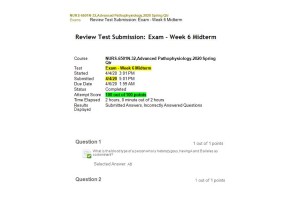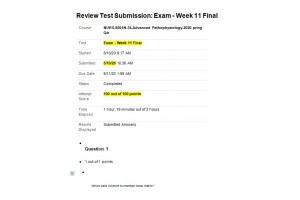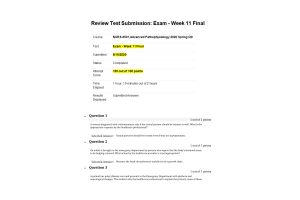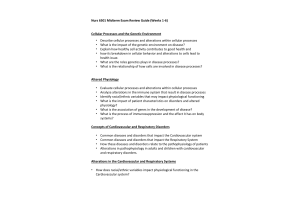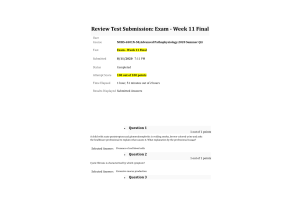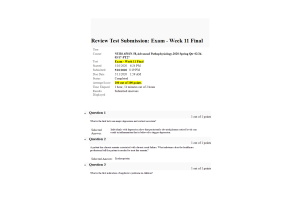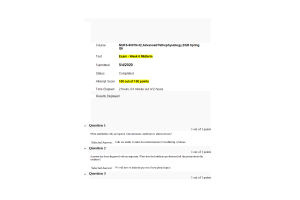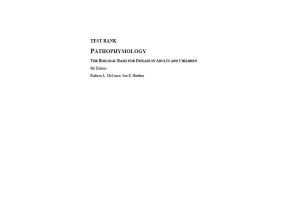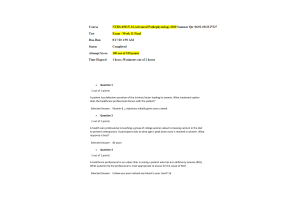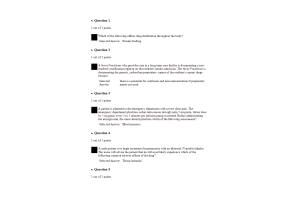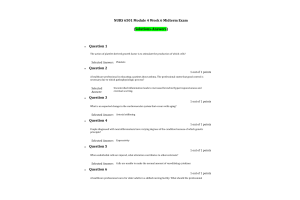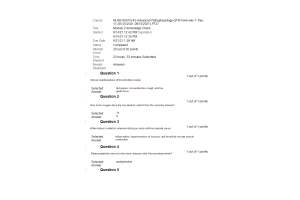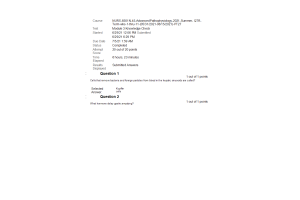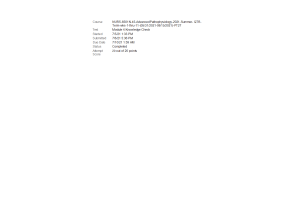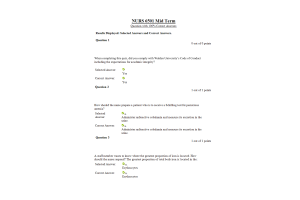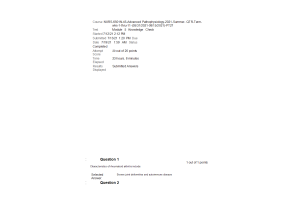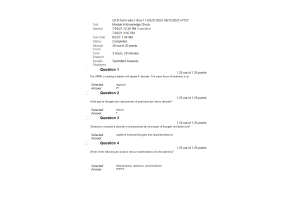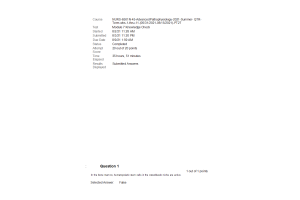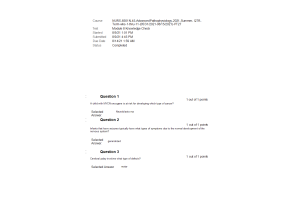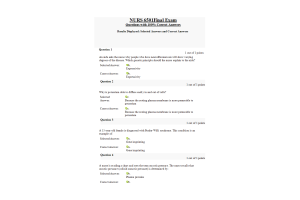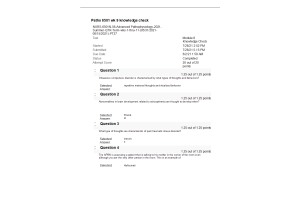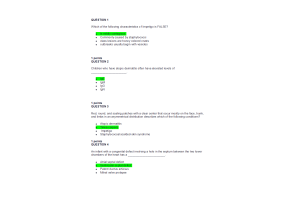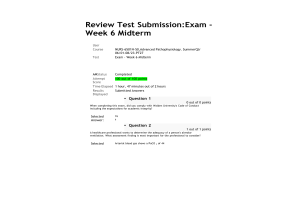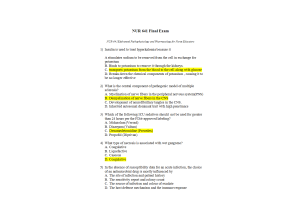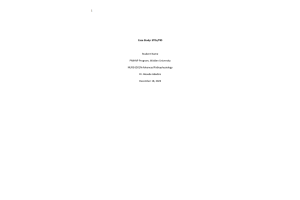NURS 6501N-24 Week 6 Midterm Exam
- $39.00
- Question: Which gastric hormone inhibits acid and pepsinogen secretion, as well as decreases the release of gastrin?
- Question: What is the cause of familial hypercholesterolemia (FH)?
- Question: If a patient develops acidosis, the nurse would expect the oxyhemoglobin dissociation curve to react in which manner?
- Question: A patient had a thyroidectomy and now reports tingling around the mouth and has a positive Chvostek sign. What laboratory finding would be most helpful to the healthcare professional?
- Question: Oxygenated blood flows through which vessel?
- Question: A Rh-negative woman gave birth to a Rh-positive baby. When discussing Rho[D] immunoglobulin with her, what information should the healthcare professional provide?
- Question: What is the inflammatory effect of nitric oxide (NO)?
- Question: A patient is having a spirometry measurement done and asks the healthcare professional to explain this test. What response by the professional is best?
- Question: Under anaerobic conditions, what process provides energy for the cell?
- Question: Which patient would the healthcare professional assess for other signs of thyrotoxic crisis?
- Question: What is the blood type of a person who is heterozygous, having A and B alleles as codominant?
- Question: A patient has a serum sodium level of 165 mEq/L. The healthcare professional explains that the clinical manifestations of confusion, convulsions, cerebral hemorrhage, and coma are caused by what mechanism?
- Question: People diagnosed with neurofibromatosis have varying degrees of the condition because of which genetic principle?
- Question: How does progressive nephron injury affect angiotensin II activity?
- Question: The glomerular filtration rate is directly related to which factor?
- Question: A professor has taught a student about skeletal alterations seen in chronic kidney disease. Which statement by the student indicates the professor needs to give more information?
- Question: What causes the edema that occurs during the inflammatory process?
- Question: A patient has a history of excessive use of magnesium-containing antacids and aluminum-containing antacids. What lab value does the healthcare professional correlate to this behavior?
- Question: Which hormone is required for water to be reabsorbed in the distal tubule and collecting duct?
- Question: A patient suffered multiple traumatic injuries and received many blood transfusions within a few days of the injuries. For which medical condition should the healthcare professional monitor the patient for?
- Question: It has been determined that a patient's tumor is in stage 2. How does the healthcare professional describe this finding to the patient?
- Question: A student studying biology asks the professor to describe how the ras gene is involved in cancer proliferation. What explanation by the professor is best?
- Question: The healthcare professional explains to a student that the amount of volume of blood in the heart is directly related to the _____ of contraction.
- Question: A healthcare professional is conducting community education on vaccinations. Which statement about vaccines does the professional include in the presentation?
- Question: Phagocytosis involves neutrophils actively attacking, engulfing, and destroying which microorganisms?
- Question: What are tumor cell markers?
- Question: What physical sign does the healthcare professional relate to the result of turbulent blood flow through a vessel?
- Question: During acidosis, the body compensates for the increase in serum hydrogen ions by shifting hydrogen ions into the cell in exchange for which electrolyte?
- Question: Which statement made by a student indicates the healthcare professional needs to describe the pericardium again?
- Question: The student asks the professor to explain what characteristic is demonstrated by lungs with decreased compliance?
- Question: A patient has been diagnosed with primary emphysema but claims there is no history of smoking. What action by the healthcare professional is most appropriate?
- Question: A student asks the professor to explain what effect natriuretic peptides have during heart failure when the heart dilates. Which response by the professor is best?
- Question: Surfactant produced by type II alveolar cells facilitates alveolar distention and ventilation by which mechanism?
- Question: A patient's chart indicates Kussmaul respirations. The student asks the healthcare professional what this is caused by. What response by the professional is most accurate?
- Question: The acute inflammatory response is characterized by fever that is produced by the hypothalamus being affected by what?
- Question: In regulating vascular mediators released from mast cells, the role of eosinophils is to release what?
- Question: What is the only surface inside the nephron where cells are covered with microvilli to increase the reabsorptive surface area called?
- Question: What is the second most commonly recognized genetic cause of intellectual disability?
- Question: The healthcare professional working with older adults teaches general infection-prevention measures as a priority for this age group due to which change in lymphocyte function?
- Question: A healthcare professional wants to determine the adequacy of a person's alveolar ventilation. What assessment finding is most important for the professional to consider?
- Question: An amniocentesis indicates a neural tube defect when an increase in which protein is evident?
- Question: What part of the kidney controls renal blood flow, glomerular filtration, and renin secretion?
- Question: A healthcare professional is assessing a child who has complete trisomy of the twenty-first chromosome. What findings does the professional relate to this condition?
- Question: Which cAMP-mediated response is related to antidiuretic hormone?
- Question: A healthcare professional is educating a patient about asthma. The professional states that good control is necessary due to which pathophysiologic process?
- Question: A patient asks the healthcare professional to describe the cause of gastroesophageal reflux disease (GERD). What response by the professional is best?
- Question: A person has hypothyroidism. What chemical does the healthcare professional advise the person to include in the diet?
- Question: What are blood pressure variations associated with?
- Question: A patient is having an IgE-mediated hypersensitivity reaction. What action by the healthcare professional is best?
- Question: Why is leakage of lysosomal enzymes during chemical injuries significant?
- Question: A patient has been diagnosed with an empyema. What does the healthcare professional tell the patient about this condition?
- Question: A healthcare professional cares for older adults in a skilled nursing facility. What should the professional assess for in these individuals related to cardiovascular functioning?
- Question: What is the most important cause of pulmonary artery constriction?
- Question: A healthcare professional is caring for a patient undergoing chemotherapy. What is the skin-related health risk the professional should assess the patient for and be prepared to treat?
- Question: A student asks the professor how a faulty negative-feedback mechanism results in a hormonal imbalance. What response by the professor is best?
- Question: A student asks why carbon monoxide causes tissue damage. What response by the professor is best?
- Question: A student asks why some vaccinations are given orally and some are given by injection. What response by the professor is best?
- Question: What is the role of the normal intestinal bacterial flora?
- Question: A patient had a myocardial infarction that damaged the SA node, which is no longer functioning as the pacemaker of the heart. What heart rate would the healthcare provider expect the patient to have?
- Question: After a partial gastrectomy, gastric bypass, or pyloroplasty, clinical manifestations that include increased pulse, hypotension, weakness, pallor, sweating, and dizziness are the results of which mechanism?
- Question: A healthcare professional is working with a person who drinks several 6-packs of beer a week. What testing does the professional encourage the person to get?
- Question: A student learns what information about acute pancreatitis?
- Question: Which term is used to identify the movement of gas and air into and out of the lungs?
- Question: The action of platelet-derived growth factor is to stimulate the production of which cells?
- Question: A student asks the healthcare professional to describe exotoxins. Which statement by the professional is best?
- Question: Which normal physiologic change occurs in the aging pulmonary system?
- Question: Free radicals play a major role in the initiation and progression of which diseases?
- Question: The pathophysiologic process of edema is related to which mechanism?
- Question: What is the cause of functional dysphagia?
- Question: What organic compound facilitates transportation across cell membranes by acting as receptors, transport channels for electrolytes, and enzymes to drive active pumps?
- Question: A student asks the healthcare professional to explain the function of the papillary muscles. What response by the professional is best?
- Question: A patient has been admitted for a possible small intestinal obstruction. What is the first sign the healthcare professional assesses for that would indicate the presence of this condition?
- Question: A patient has portal hypertension-induced splenomegaly. Which lab value would the healthcare professional associate with this condition?
- Question: A patient has a pulmonary capillary wedge pressure of 30mmHg. What assessment finding by the healthcare professional would be most consistent with this reading?
- Question: Which chamber of the heart endures the highest pressures?
- Question: A parent wants to know how to prevent type 1 diabetes in the newborn. The healthcare professional explains that prevention is not possible, because which of these is a major characteristic of type 1 diabetes mellitus?
- Question: A person has acne, easy bruising, thin extremities, and truncal obesity. The healthcare professional assesses the person for which of these?
- Question: Pressure in the left ventricle must exceed pressure in which structure before the left ventricle can eject blood?
- Question: Which statement is true about phagocytosis?
- Question: What does vomiting-induced metabolic alkalosis cause?
- Question: Neurotransmitters affect the postsynaptic membrane by binding to which structure?
- Question: A healthcare professional is educating a patient on asthma. The professional tells the patient that the most successful treatment for chronic asthma begins with which action?
- Question: The Bainbridge reflex is thought to be initiated by sensory neurons in which cardiac location?
- Question: Which renal change is found in older adults?
- Question: A patient has a peptic ulcer related to h. pylori bacteria. What treatment does the healthcare professional educate the patient on?
- Question: A patient has diabetes mellitus. A recent urinalysis showed increased amounts of protein. What therapy does the healthcare provider educate the patient that is specific to this disorder?
- Question: During cell injury caused by hypoxia, why does an increase in the osmotic pressure within the cell occur?
- Question: The student asks the professor why water and electrolytes are transported in both directions through tight junctions and intercellular spaces rather than across cell membranes. What response by the professor is best?
- Question: What mechanisms occur in the liver cells as a result of lipid accumulation?
- Question: Which characteristic is the most important determinant of immunogenicity when considering the antigen?
- Question: When endothelial cells are injured, what alteration contributes to atherosclerosis?
- Question: The cardiac electrical impulse normally begins spontaneously in the sinoatrial (SA) node because of what reason?
- Question: What effect is a result of inhibiting the parasympathetic nervous system with a drug such as atropine?
- Question: A healthcare professional tells a student that a patient has lost atrial kick. What would the student expect to see when examining this patient?
- Question: Which cardiac chambers have the thinnest wall and why?
- Question: What is the process that ensures mitral and tricuspid valve closure after the ventricles are filled with blood?
- Question: Vaccinations are able to provide protection against certain microorganisms because of what?
- Question: Renal failure is the most common cause of which type of hyperparathyroidism?
- Question: A healthcare professional is caring for a patient who has continuous increases in left ventricular filing pressures. What disorder would the professional assess the patient for?
- Question: A patient diagnosed with diabetic ketoacidosis (DKA) has the following laboratory values: arterial pH 7.20; serum glucose 500 mg/dL; positive urine glucose and ketones; serum potassium (K +) 2 mEq/L; serum sodium (Na +) 130 mEq/L. The patient reports that he has been sick with the flu for 1 week. What relationship do these values have to his insulin deficiency?
- Question: When completing this exam, did you comply with Walden University's Code of Conduct including the expectations for academic integrity?

